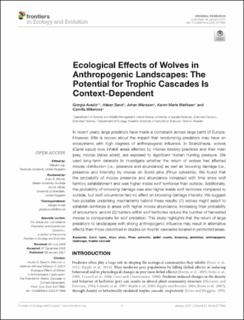Ecological Effects of Wolves in Anthropogenic Landscapes: The Potential for Trophic Cascades Is Context-Dependent
Peer reviewed, Journal article
Published version
Permanent lenke
https://hdl.handle.net/11250/2829365Utgivelsesdato
2021Metadata
Vis full innførselSamlinger
Sammendrag
In recent years, large predators have made a comeback across large parts of Europe. However, little is known about the impact that recolonizing predators may have on ecosystems with high degrees of anthropogenic influence. In Scandinavia, wolves (Canis lupus) now inhabit areas affected by intense forestry practices and their main prey, moose (Alces alces), are exposed to significant human hunting pressure. We used long-term datasets to investigate whether the return of wolves has affected moose distribution (i.e., presence and abundance) as well as browsing damage (i.e., presence and intensity) by moose on Scots pine (Pinus sylvestris). We found that the probability of moose presence and abundance increased with time since wolf territory establishment and was higher inside wolf territories than outside. Additionally, the probability of browsing damage was also higher inside wolf territories compared to outside, but wolf occurrence had no effect on browsing damage intensity. We suggest two possible underlying mechanisms behind these results: (1) wolves might select to establish territories in areas with higher moose abundance, increasing their probability of encounters, and/or (2) hunters within wolf territories reduce the number of harvested moose to compensate for wolf predation. This study highlights that the return of large predators to landscapes with strong anthropogenic influence may result in alternative effects than those described in studies on trophic cascades located in protected areas.

